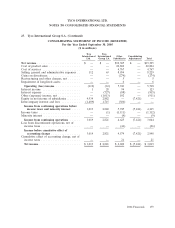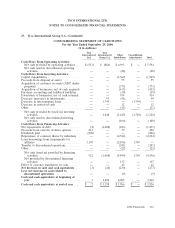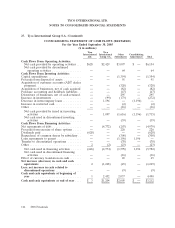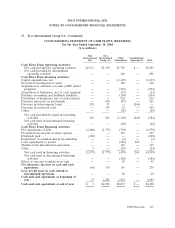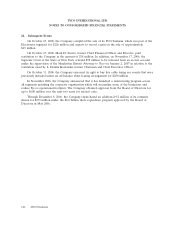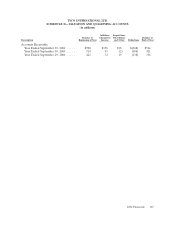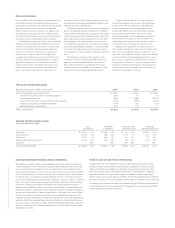ADT 2006 Annual Report Download - page 231
Download and view the complete annual report
Please find page 231 of the 2006 ADT annual report below. You can navigate through the pages in the report by either clicking on the pages listed below, or by using the keyword search tool below to find specific information within the annual report.
NON-GAAP MEASURES
FREE CASH FLOW RECONCILIATION
RECONCILIATION TO “FREE CASH FLOW”: 2004 2005 2006
Net cash provided by operating activities $ 5,205 $ 6,154 $ 5,594
Decrease in sale of accounts receivable programs 929 18 9
Capital expenditures, net (987) (1,263) (1,514)
Acquisition of customer accounts (ADT dealer program) (254) (328) (373)
Purchase accounting and holdback liabilities (104) (47) (19)
Voluntary pension contributions 567 115 2
FREE CASH FLOW $5,356 $4,649 $3,699
ORGANIC GROWTH RECONCILIATION
(Year Ended September 29, 2006)
NET FOREIGN ACQUISITION/ ORGANIC
REVENUES CURRENCY (DIVESTITURE) REVENUE GROWTH
Electronics $ 12,724 8.1% $ (148) -1.3% $ 8 0.1% $ 1,090 9.3%
Fire & Security 11,653 1.3% (60) - 0.5% (117) -1.1% 327 2.9%
Healthcare 9,641 1.0% (93) -1.0% 14 0.1% 177 1.9%
Engineered Products & Services 6,942 7.5% (25) -0.4% (1) 0.0% 512 7.9%
Corporate — NM — NM (29) NM — NM
TOTAL NET REVENUES $40,960 4.2% $(326) -0.8% $(125) -0.4% $2,106 5.4%
“Free cash flow” (FCF) and “organic revenue growth” are
non-GAAP measures and should not be considered
replacements for GAAP results. These measures should
be used in conjunction with the most comparable
GAAP financial measures. Investors are urged to read
the company’s financial statements as filed with the
Securities and Exchange Commission for more informa-
tion about the most comparable GAAP measures.
The difference between Cash Flows from Operating
Activities (the most comparable GAAP measure) and
FCF (the non-GAAP measure) consists mainly of sig-
nificant cash outflows that the company believes
are useful to identify. FCF permits management
and investors to gain insight into the figure that
management employs to measure cash that is free
from any significant existing obligation. It is also a
significant component in the company’s incentive
compensation plans. The difference reflects the
impact from: the sale of accounts receivable pro-
grams, net capital expenditures, acquisition of
customer accounts (ADT dealer program), cash paid
for purchase accounting and holdback liabilities and
voluntary pension contributions.
The impact from the sale of accounts receivable pro-
grams and voluntary pension contributions is added or
subtracted from the GAAP measure because this activity
is driven by economic financing decisions rather than
operating activity. Capital expenditures and the ADT
dealer program are subtracted because they repre-
sent long-term commitments. Cash paid for purchase
account ing and holdback liabilities is subtracted from
Cash Flow from Operating Activities because these
cash outflows are not available for general corporate
uses.
The limitation associated with using FCF is that
it subtracts cash items that are ultimately within man-
agement’s and the Board of Directors’ discretion to
direct and that therefore may imply that there is less
or more cash that is available for the company’s pro-
grams than the most comparable GAAP measure.
“Organic revenue growth” is a useful measure
used by the company to measure the underlying
results and trends in the business. The difference
between reported net revenue growth (the most
comparable GAAP measure) and organic revenue
growth (the non-GAAP measure) consists of the
impact from foreign currency, acquisitions and divesti-
tures and other changes that do not reflect the
underlying results and trends (for example, revenue
reclassifications and changes to the fiscal year).
Organic revenue growth is a useful measure of
the company’s performance because it excludes items
that: i) are not completely under management’s con-
trol, such as the impact of foreign currency exchange;
or
ii) do not reflect the underlying growth of the com-
pany,
such as acquisition and divestiture activity, or
revenue reclassification. It is also a component of the
company’s compensation programs. The limitation of
this measure is that it excludes items that have an
impact on the company’s revenue.
CAUTION CONCERNING FORWARD-LOOKING STATEMENTS
This report may contain certain “forward-looking statements” within the meaning
of the United States Private Securities Litigation Reform Act of 1995. These state-
ments are based on management’s current expectations and are subject to risks,
uncertainty, and changes in circumstances, which may cause actual results, perfor-
mance, or achievements to differ materially from anticipated results, performance,
or achievements. All statements contained herein that are not clearly historical in
nature are forward-looking and the words “anticipate,” “believe,” “expect,” “estimate,”
“plan,” and similar expressions are generally intended to identify forward-looking
statements. The forward-looking statements in this report include statements
addressing the following subjects: future financial condition and operating results.
Economic, business, competitive and/or regulatory factors affecting the company’s
businesses are examples of factors, among others, that could cause actual results
to differ materially from those described in the forward-looking statements. The
company is under no obligation to (and expressly disclaims any such obligation to)
update or alter its forward-looking statements whether as a result of new informa-
tion, future events, or otherwise. More detailed information about these and other
factors is set forth in Tyco’s Annual Report on Form 10-K for the fiscal year ended
September 29, 2006.
FORM 10-K AND SEC AND NYSE CERTIFICATIONS
A copy of the Form 10-K filed by the company with the Securities and Exchange
Commission (SEC) for fiscal 2006, which includes as Exhibits the Chief Executive
Officer and Chief Financial Officer Certifications required to be filed with the SEC
pursuant to Section 302 of the Sarbanes-Oxley Act, is included herein. Additional
copies of the Form 10-K may be obtained by shareholders without charge upon
written request to Tyco International, 2nd Floor, 90 Pitts Bay Road, Pembroke HM 08,
Bermuda. The Form 10-K is also available on the company’s website at www.tyco.com.
The company has filed with the New York Stock Exchange (NYSE) the Certification of
its Chief Executive Officer confirming that the company has complied with the NYSE
corporate governance listing standards.
Design: VSA Partners, New York Photos: Chris Buck Printing: CGI North America.


